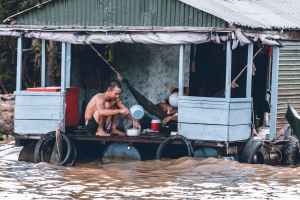Floods, an ever-looming threat worldwide, demand not only our respect but also meticulous preparation to overcome their devastating impact. In this comprehensive guide, we delve into the complexities of flood survival, drawing insights from real-life events and supporting facts to equip you with the knowledge needed to navigate through these perilous waters.
1. Stay Informed:
When it comes to floods, knowledge is indeed power. In instances like Hurricane Katrina in 2005, where communication breakdowns exacerbated the disaster, staying informed through diverse channels becomes crucial. Rely on weather alerts from various sources, including radio, news broadcasts, and weather apps.
Emergency communication is equally vital. The experience of Hurricane Harvey in 2017 underscores the importance of establishing robust communication channels with family and neighbors. A well-connected community is better equipped to share critical information and support during emergencies.
2. Evacuation Plan:
Having a detailed evacuation plan can make a significant difference. Take inspiration from the Midwest floods of 1993, where diverse escape routes to higher ground or shelters proved invaluable. Practice evacuation drills with your family to ensure everyone is familiar with the plan, as seen in the efficient response to Typhoon Hagibis in Japan in 2019.
3. Emergency Kit:
Your emergency kit is your lifeline during floods. Learn from the aftermath of Hurricane Maria in 2017, where a shortage of food aggravated the crisis. Pack a three-day supply of non-perishable food and water, along with a well-equipped first aid kit, personal hygiene items, essential documents, and some cash.
4. Secure Your Home:
Minimize damage to your home by elevating electrical appliances, installing check valves in plumbing to prevent sewage backup (as seen in the United Kingdom floods), and waterproofing basement walls. Elevate furniture and valuables to reduce potential flood damage.
5. Early Evacuation:
If authorities recommend evacuation, do not hesitate. Delayed evacuation during Hurricane Katrina resulted in tragic consequences. Learn from designated evacuation routes, as demonstrated during the Kerala floods in 2018, where following these routes reduced the risk of being stranded.
6. Safe Shelter:
In case evacuation is not possible, seek refuge in safe and elevated spaces within your home. Instances of successful rooftop rescues during Hurricane Harvey emphasize the importance of high ground.
7. Avoid Floodwaters:
Floodwaters are rife with dangers. Learn from the aftermath of Hurricane Katrina and avoid walking or driving through floodwaters, as even seemingly shallow water can conceal hazardous elements.
8. Communication:
Maintain open channels with family, neighbors, and emergency services. Successful communication strategies during the 2004 Indian Ocean tsunami show that constant updates are essential. Use battery-powered devices, like radios, to stay informed during power outages.
9. Post-Flood Safety:
Exercise caution when returning home after the floodwaters recede. Structural damage and contaminated water, as seen post-Hurricane Sandy, are potential hazards. Wait for official clearance before re-entering your home.
—
Surviving a flood demands more than just passive readiness; it requires active preparation based on real-world examples and supporting facts. By incorporating the lessons learned from past events, you can navigate the challenges of floods with resilience and emerge safely on the other side. Preparedness is not an option; it’s a necessity when facing the unpredictable force of nature.





